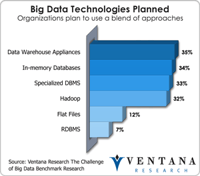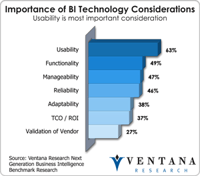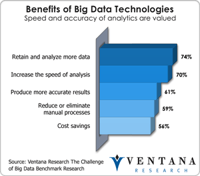Big data involves interplay between different data management approaches and business intelligence and operational systems, which makes it imperative that all sources of business data be integrated efficiently and that organizations be able to easily adapt to new data types and sources. Our recent big data benchmark research confirmed that big data storage technologies continue to follow many approaches, including appliances, Hadoop, and in-memory and specialized DBMSes. With the variety,...
Read More
Topics:
Big Data,
Data Quality,
Master Data Management,
Business Technology Innovation,
IT Performance,
IT Research,
Business Analytics,
Business Intelligence,
Data Integration,
Information Applications,
Information Management,
Operational Intelligence
Business intelligence software is supposed to help businesses access and analyze data and communicate analytics and metrics. I have witnessed improvements to BI software over the years, from mobile and collaboration to interactive discovery and visualization, and our Value Index for Business Intelligence finds a mature set of technology vendors and products. But even as these products mature in capabilities, the majority lack features that would make them easy to use. Our recent research on ...
Read More
Topics:
Big Data,
Sales Performance,
Supply Chain Performance,
Mobile Technology,
Natural Language,
Business Technology Innovation,
IT Performance,
Operational Performance,
Business Analytics,
Business Collaboration,
Business Intelligence,
Business Mobility,
Business Performance,
Cloud Computing,
Customer & Contact Center,
Financial Performance,
Information Management,
Location Intelligence,
Operational Intelligence,
Workforce Performance,
Discovery
Our research agenda for 2012 in human capital management outlined the importance of workforce management for all organizations. One provider, WorkForce Software, provides systems that support scheduling, time and attendance, leave and absence and fatigue management. As I noted in my last analysis on WorkForce Software, the company’s focus on the fatigue aspect of workforce management, especially in white-collar environments such as transportation, utilities and healthcare, has provided them...
Read More
Topics:
Big Data,
Sales Performance,
SAP,
Social Media,
Supply Chain Performance,
Sustainability,
Human Capital Management,
SuccessFactors,
Business Technology Innovation,
IT Performance,
IT Research,
Operational Performance,
Business Analytics,
Business Collaboration,
Business Intelligence,
Business Mobility,
Business Performance,
Cloud Computing,
Customer & Contact Center,
Financial Performance,
Governance, Risk & Compliance (GRC),
Information Applications,
Information Management,
Location Intelligence,
Operational Intelligence,
Workforce Performance,
HTML5,
Time & Attendance,
Workforce Management
Anyone who focuses on the practical uses of information technology, as I do, must consider the data aspects of adopting any new technology to achieve some business purpose. Reliable data must be readily available in the necessary form and format, or that shiny new IT bauble you want to deploy will fall short of expectations. Our research benchmarks cover a range of core business and IT processes, and they regularly demonstrate that data deficiencies are a root cause of issues organizations have...
Read More
Topics:
Social Media,
Supply Chain Performance,
GRC,
IBM Business Analytics,
Business Technology Innovation,
Operational Performance,
Business Analytics,
Business Collaboration,
Business Intelligence,
Business Performance,
CIO,
Customer & Contact Center,
Financial Performance,
Governance, Risk & Compliance (GRC),
Information Applications,
Information Management,
Location Intelligence,
Operational Intelligence,
Workforce Performance,
CFO,
finance
More than 1,000 people attended the 32nd annual Information Builders Summit conference this week to learn about the company’s advances in big data, business analytics, cloud computing, mobile technology and social media, which CEO and founder Gerald Cohen announced and demonstrated during his keynote address. With WebFOCUS version 8, Information Builders has made significant strides in a range of technology areas to support analytics and visualization since my analysis after last year’s...
Read More
Topics:
Big Data,
Mobile,
Sales Performance,
Social Media,
Supply Chain Performance,
Sustainability,
Business Technology Innovation,
IT Performance,
IT Research,
Operational Performance,
Analytics,
Business Analytics,
Business Collaboration,
Business Intelligence,
Business Performance,
Cloud Computing,
Customer & Contact Center,
Financial Performance,
Governance, Risk & Compliance (GRC),
Information Applications,
Information Management,
Location Intelligence,
Operational Intelligence,
Workforce Performance,
Search
I attended the annual SAP Influencer Summit (Twitter #SAPSummit), at which executives from SAP meet with analysts and customers from around the world to discuss the company’s direction. Pointing out that in 2012 SAP will reach its 40th anniversary of operations, chief communications officer Hubertus Kulpus and chief marketing officer Jonathan Becher kicked off the summit, then passed the microphones to co-CEO Jim Hagemann-Snabe and CTO Vishal Sikka for overviews of the business and technology...
Read More
Topics:
Mobile,
Sales,
Sales Performance,
SAP,
Social Media,
Supply Chain Performance,
Sustainability,
Human Capital Management,
Smart Phones,
Business Technology Innovation,
IT Performance,
IT Research,
Operational Performance,
Business Analytics,
Business Collaboration,
Business Intelligence,
Business Mobility,
Business Performance,
Business Technology,
CIO,
Cloud Computing,
Customer & Contact Center,
Financial Performance,
Governance, Risk & Compliance (GRC),
Information Applications,
Information Management,
Information Technology,
Location Intelligence,
Operational Intelligence,
Workforce Performance,
Business Applications,
CFO,
COO,
CRM,
HR,
Sybase,
Tablets,
Talent Management,
Digital Technology
Just when it seemed that Hewlett-Packard’s new management team led by CEO Leo Apotheker had a growing and solidifying technology agenda that included mobile computing, yesterday it all changed.
Read More
Topics:
Sales Performance,
Social Media,
Supply Chain Performance,
Sustainability,
Google,
Business Technology Innovation,
IT Performance,
IT Research,
Operational Performance,
Analytics,
Business Analytics,
Business Collaboration,
Business Intelligence,
Business Mobility,
Business Performance,
CIO,
Cloud Computing,
Collaboration,
Customer & Contact Center,
Enterprise Software,
Financial Performance,
Governance, Risk & Compliance (GRC),
HP,
Information Applications,
Information Management,
Information Technology,
Location Intelligence,
Mobility,
Operational Intelligence,
Workforce Performance,
HP Touchpad,
Digital Technology
The recent buzz around business analytics has generated resurgent conversation about what businesses need from their data to optimize business processes and make better decisions. Our benchmark research on business analytics in more than 2,500 organizations produced unprecedented information about business and IT usage and competency with analytics. It confirmed that effective use of business analytics requires a balance of people and skills, processes, information and technology not just to...
Read More
Topics:
Sales Performance,
Social Media,
Supply Chain Performance,
Sustainability,
Business Technology Innovation,
IT Performance,
IT Research,
Operational Performance,
Business Analytics,
Business Collaboration,
Business Intelligence,
Business Mobility,
Business Performance,
CIO,
Cloud Computing,
Customer & Contact Center,
Financial Performance,
Governance, Risk & Compliance (GRC),
Information Applications,
Information Management,
Location Intelligence,
Operational Intelligence,
Uncategorized,
Workforce Performance,
Business Planning,
CFO
At this year’s Information Builders Summit, the company’s annual conference for users and analysts (Twitter: #Summit2011) in Dallas, the long-time supplier of business intelligence and information management software showed how it has been able to sustain double-digit revenue growth thanks to highly accessible and scalable software that operates on a variety of platforms and data sources. Its recent expansion into information management, master data management and integration helps...
Read More
Topics:
Sales Performance,
Social Media,
Supply Chain Performance,
Sustainability,
Google,
Playbook,
RIM,
Business Technology Innovation,
IT Performance,
IT Research,
Operational Performance,
Business Analytics,
Business Collaboration,
Business Intelligence,
Business Mobility,
Business Performance,
CIO,
Cloud Computing,
Customer & Contact Center,
Financial Performance,
Governance, Risk & Compliance (GRC),
Information Applications,
Information Builders,
Information Management,
Location Intelligence,
Mobility,
Operational Intelligence,
Uncategorized,
Workforce Performance,
Digital Technology
At SAP’s annual SAPPHIRE NOW conference (Twitter: #SAPPHIRENOW) this month, the company introduced a new portfolio of human capital management applications that will be available on many devices and added mobility options for users, including offerings for smartphones and tablets and cloud computing. This move beyond the traditional on-premises approach of SAP’s ERP Human Capital Management product suite is a critical step forward for SAP if it is to remain relevant for HR organizations.
Read More
Topics:
Big Data,
Performance Management,
Sales Performance,
Social Media,
Supply Chain Performance,
Sustainability,
Human Capital Management,
Metrics,
Mobile Applications,
Business Technology Innovation,
Operational Performance,
Business Analytics,
Business Collaboration,
Business Intelligence,
Business Mobility,
Business Performance,
Cloud Computing,
Customer & Contact Center,
Financial Performance,
Governance, Risk & Compliance (GRC),
Information Management,
Workforce Performance,
data mart,
Talent Management,
Workforce Analytics












